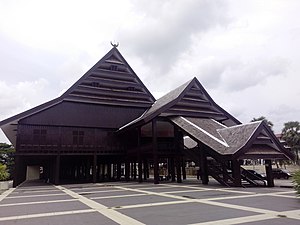Pusatoka
This article is incomplete because it is pending further input from participants, or it is a work-in-progress by one author. Please comment on this article's talk page to share your input, comments and questions. Note: To contribute to this article, you may need to seek help from the author(s) of this page. |
Busatoka
ᨅᨘᨔᨈᨚᨀ | |
|---|---|
Clockwise from top:Fort Saint Dominique with Busatoka harbour in the background, Church of St. Martin, House of the people, presidential villa, Busatoka international airport, fishing boats in Busatoka harbour | |
| Etymology: Foam City | |
| Special Municipality | Busatoka Special Municipality |
| Founded by | King Gumelar II. of Batu |
| Government | |
| • Body | Busatoka City Council |
| • Mayor | Botak Mainaky (Kapulakan People's Party) |
| Area | |
| • Total | 104.7 km2 (40.4 sq mi) |
| Elevation | 15 m (49 ft) |
| Population (2022) | |
| • Total | 109,437 |
| • Density | 1,000/km2 (2,700/sq mi) |
| Demonym | Busatokan |
| Postal Code | 101 |
| Website | butasoka.gov.kl |
Busatoka (Kapulakan:ᨅᨘᨔᨈᨚᨀ) is the oldest city of Kapulaka and its political, cultural and economic centre while also being the home to roughly one third of the nations population. Next to its function as national capital Busatoka is also the capital of Poeok, the state it is located in.
The history of settlements in the bay of Busatoka probably traces back to the first humans to arrive on the Kapulakan Archipelago but volcanic activity up to the 13th century destroyed most of those early structures leaving only a very small archeological record. This same volcanic activity is also generally regarded as the one of the major factors for the construction of stilt houses by the kapulakans, a tradition that is kept alive to this day. Its generally assumed that by the time the Batu unified the islands under their rule Busatoka already was the biggest settlement in the Archipelago.
History
Foundation
Human settlements in Busatoka bay probably trace back to roughly 1200 years ago when prehistoric kapulakans built stilt houses in the shallow waters of the bay. Around 1000 BCE. the settlement became the staging grounds of the Batu-clans attacks on other clans and families in the archipelago. After he launched the unification wars against the 7 other major clans of the kapulakan archipelago king Gumelar I. of Batu made Busatoka his official base of operations and also built the first land installations. As he died soon after having unified the archipelago under his families rule it became the role of his son Gumelar II. to expand the capital in 1215. Under the rule of Gumelar II. the town was expanded from being mostly located on stilts to also include land settlements, including temples and especially the Royal palace of Busatoka.

. As the other powerful of the archipelago still posed a potential threat to Batu rule a fort to protect the population and especially the cities food reserves was constructed in 1244.
Aguda-period
Colonial-period
Gaullican-occupation
In 1928 Cahya Sitepu created the Independent Busatoka Fire Fighter Brigade.
The Great war
During the Great war Gaullica bolstered its forces on Kapulaka, especially expanding its ammonition depots and hospital facilities. Other than that the only time Busatoka was touched by the war was in 1932 when a weranian cruiser squadron bombarded the city with the goal of destroying Fort Saint Dominique, the gaullican military headquarters for kapulaka. While the bombardment failed to destroy any military installation, largely becaue weranian maps of the island were outdated or straight up incorrect, it instead destroyed several warehouses belonging to a cooperative of local shipbuilders and a gaullican fish raffinery.
The resulting fire not just destroyed a large amount of wood needed for the construction of fishing boats but also extended to the local neighbourhood where it destroyed 26 houses, the fire burned for a total of 6 hours before the combined efforts of gaullican and kapulakan firefighters managed to contain it. In total 32 people, including 6 Firefighters died
Weranian-occupation
Following the Gaullican defeat in the Great War Werania took over the administration of Kapulaka.
Modern period
Federation of the Corriveau-islands
August 20th coup
On the 20th of August 1964 the armed wing of the People's Freedom Front of Kapulaka(HRMK), the Republican Guard of Kapulaka stormed the government building in Busatoka. After minor skirmishes with the National gendarmarie they entered the presidential office and arrested President Lotulelei. Afterwards the leader of the Republican Guard Ajat Sanaky was declared provisional president. The fighting between members of the Republican Guard and Lotulelei loyalists continued throughout Busatoka for the next week until HRMK control of the entire city was secured. After the establishment of the modern kapulakan republic the first municipal elections in Busatoka were held and Kusworo Rehatta sworn in as the first freely elected mayor of Busatoka.
Politics
Municipal Government
Mayor
City Council
The City Council (Kaoulakan: Makota)
Administrative divisions
Busatoka has 14 subdivisions
Economy
Transportation
Busatoka Tram and Bus Corporation
Tram services in Busatoka were first established in the 1920s to transport workers to the farmland of inner Poeok. In the 1950s public transport was expanded with a busline connecting the harbour to the city center and the main train station. In 1976 the management of all public transport in Busatoka was unified into the Busatoka tram and bus corporation which is operated by the ministry of transportation. This move was necessary as poltical divisions between the BWK and PMN regarding the topic began to threaten the normal operations of the city government.
Busatoka International Airport
The first Airfield in Busatoka was constructed to facilitate the aircraft of the newly established coast guard in 1953. It was later expanded and opened for civilian use in 1957. In 1985 it was inaugurated as an international airport with the flag carrier Air Kapulaka performing the first flight from Kapulaka to Werania.







